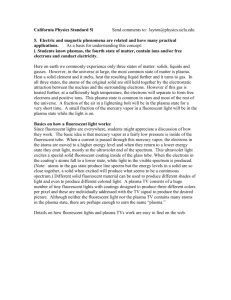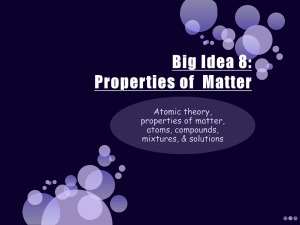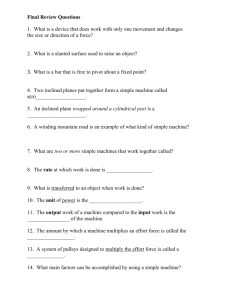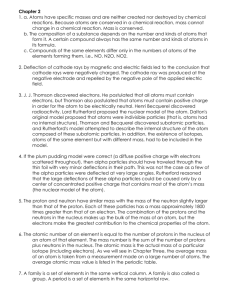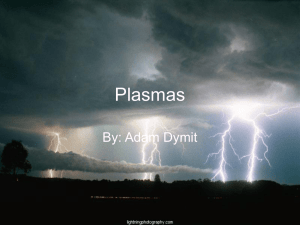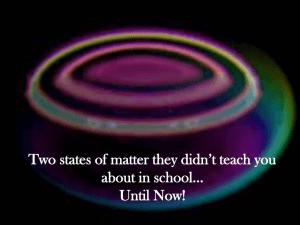The 4 Basic States of Matter
advertisement
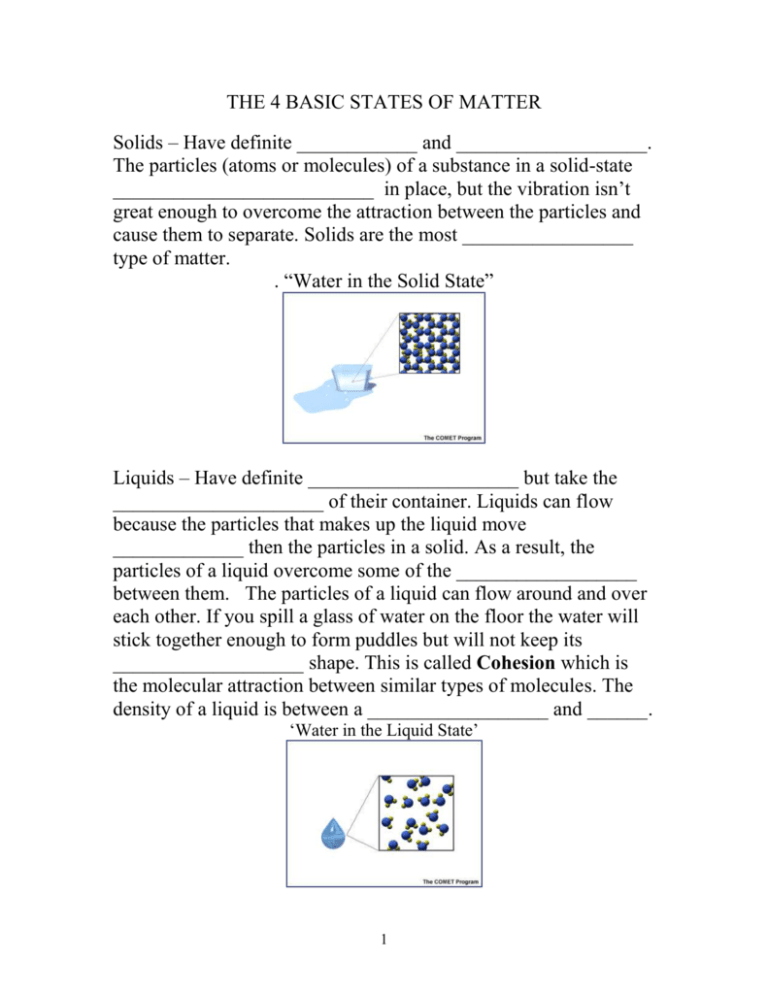
THE 4 BASIC STATES OF MATTER Solids – Have definite ____________ and ___________________. The particles (atoms or molecules) of a substance in a solid-state __________________________ in place, but the vibration isn’t great enough to overcome the attraction between the particles and cause them to separate. Solids are the most _________________ type of matter. . “Water in the Solid State” Liquids – Have definite _____________________ but take the _____________________ of their container. Liquids can flow because the particles that makes up the liquid move _____________ then the particles in a solid. As a result, the particles of a liquid overcome some of the __________________ between them. The particles of a liquid can flow around and over each other. If you spill a glass of water on the floor the water will stick together enough to form puddles but will not keep its ___________________ shape. This is called Cohesion which is the molecular attraction between similar types of molecules. The density of a liquid is between a __________________ and ______. ‘Water in the Liquid State’ 1 Gases – Take on the ________________ and _________________ of its container. Gases can _________________. The particles of a gas move the _____________________ of any state of matter. They have the ability to overcome the ________________ between them and separate entirely from each other. That is why a gas will spread out in all__________________, filling up a balloon, a room, or the atmosphere. Gases are the _____________ dense type of matter. Video review http://vespr.org/chemistry/phases-of-matter/properties-of-solids-liquidsand-gases “Water in the Gaseous State” Vocabulary To Understand Plasma State Of Matter Atom and its Basic Parts – An atom is the smallest particle into which an element (such as gold) can be divided and still maintain the ____________________ of that element. Atoms are considered the building blocks of ___________________. Atoms are made up of smaller particles called _____________________ which have no electrical charge (neutral), ____________________ which have a positive (+) electrical charge, and ____________________ which have a negative (-) electrical charge. The protons and neutrons are located in the center of an atom called the _______________________. The electrons _______________ around the nucleus of the atom. Atoms are electrically neutral because they have the _____________________ number of positive protons as negative electrons. 2 http://phet.colorado.edu/en/simulation/build-an-atom - website use Ion – Is an atom or particle that has an ________________ charge. If an atom _______________ electrons it becomes negatively charged because it would have more negative ________________ than positive ________________. If an atom loses electrons it becomes _____________________ charged because it would have more __________________ protons than ___________________ electrons. Plasma - Plasmas are a lot like gases, but the atoms are different because they are made up of free electrons and ___________ of the element. A plasma is like two gasses intermixed – a gas of ________________ and a gas of _____________. Plasma is electrically ___________________ because the positive and negative charges balance each other out. Plasma is the most common form of matter because it is found in space and makes up the majority of matter in _____________ like our sun. They aren't things that happen regularly on Earth. If you have ever heard of The Northern Lights and Southern Lights, these lights in the sky are an example of matter on the Earth in the _________________ state. 3 Finding Plasma You won't find plasmas just anywhere. However, there may be some in front of you. Think about a fluorescent ____________ _____________. They are not like regular light bulbs. Inside the long tube is a ___________. ________________ flows through the tube when the light is turned on. The ____________________ acts as that special energy and charges up the gas. This charging and exciting of the atoms creates glowing plasma inside the bulb. Another example of plasma is a neon sign. Just like a fluorescent light, neon signs are glass tubes filled with _____________. When the light is turned on, the ___________________ flows through the tube. The electricity charges the gas, possibly neon, and creates plasma inside of the tube. The plasma glows a special color depending on what kind of gas is inside. You also see plasma when you look at ___________. ___________ are big balls of gases at really high temperatures. The high temperatures charge up the atoms and create__________________. Stars are another good example of how the ___________________________ of plasmas can be very different. Fluorescent lights are ______________ compared to really _______________ stars. They are still both forms of plasma, even with different physical characteristics. Like a gas it does not have a definite ________________ or _____________ but takes the shape of its container. 4 CHANGING STATES OF MATTER Phase Diagram Freezing is the phase change as a substance changes from a _____________ to a ____________________. Melting is the phase change as a substance changes from a ______________ to a ____________________. Condensation is the phase change as a substance changes from a ____________ to a _________________. Vaporization or evaporation is the phase change as a substance changes from a ______________to a ______________. Sublimation is the phase change as a substance changes from a _____________ to a __________________ without passing through the intermediate state of a liquid. 5 Deposition is the phase change as a substance changes from a ___________ to a _________________ without passing through the intermediate state of a liquid. To change a substance from a solid to a liquid or a liquid to a gas you must add _________________ energy to the particles of matter. Adding heat energy to a substance will make the substance expand and take up _______________ _____________ or volume. The substance that is heated will also be ___________ dense. To change a substance from a gas to a liquid or a liquid to a solid you must take away ____________________ energy, which will make the particles of matter ___________________. Taking away heat energy will cause a substance to contract and take up _________ ____________________ or volume. Air pressure also affects the _______________________ in which a solid turns to a liquid and a liquid turns to a gas. The greater the atmospheric pressure the more _______________ energy it takes for a material to change state. The less the atmospheric pressure the __________________ heat energy it takes for a material to change state. High up in the mountains water will boil at temperatures a lot ___________________ than at sea level. It takes ______________________ to cook food in water because the water is at a much lower temperature. Instead of using the word vaporization we can use the word “evaporation”. The enthalpy of a system changing state can be viewed as the heat added or lost by the system; as we go from a solid to gas we are _________________ heat to the system. 6

